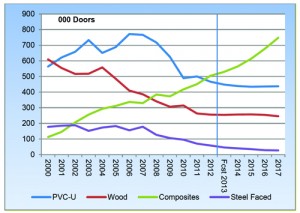Palmer’s report on entrance door market reveals increased dominance of composites
 The latest Palmer report reveals a new market leader in entrance door materials, which will be the main beneficiary of the next few years of growth. After years of growing popularity, 2012 is the year when composites finally took over from PVC-U as the most popular door material. That’s according to Palmer Market Research, whose latest study on the domestic entrance door market has just been published. And the improved forecast that Robert Palmer provides for the next few years has composites as the main beneficiary, as it’s the only door material, aside from the much smaller timber engineered, to grow to 2017, as the graph illustrates.
The latest Palmer report reveals a new market leader in entrance door materials, which will be the main beneficiary of the next few years of growth. After years of growing popularity, 2012 is the year when composites finally took over from PVC-U as the most popular door material. That’s according to Palmer Market Research, whose latest study on the domestic entrance door market has just been published. And the improved forecast that Robert Palmer provides for the next few years has composites as the main beneficiary, as it’s the only door material, aside from the much smaller timber engineered, to grow to 2017, as the graph illustrates.
Just 19% of the total market as recently as 2007, composites took 38% last year, and will be half of it by 2017. Palmer notes that the combination of “increasingly competitive pricing [alongside] perceived technological superiority and appearance”, means that there’s “no reason why they should not continue to gain share.” Overall, the 2012 market was down 1% on the previous year in both volume and value. Home improvements, which counts for just over half the total market, fell to its lowest level for 30 years. However, this was offset by slight growth in the new housing sector and surprisingly, also in the cash-strapped social housing sector too – probably due to essential maintenance work.
And Palmer believes that while this year will show a small decline, 2014 to 2017 are growth years, with the 2017 figure 13% up on 2012, as a more buoyant housing market, fuelled by government initiatives, is compounded by increasing consumer confidence. So while the social sector continues to decline, new housing and home improvements will both show double-digit growth. But as composites grow in popularity, more traditional door materials will decline. PVC-U still comes first in the home improvements category, however Palmer predicts a long-term downward trend here, as in the other categories, as composites continue to gain market share.
Wood was 19% of the market in 2012, the second biggest player in home improvements and third biggest in new housing, but again, will decline over the next five years, by 3%. Steel faced doors were the market leader in new housing up until 2010, but will represent just 9% (and only 2% overall) in 2017. The Market for Domestic Entrance Doors in Great Britain, 2013 edition, was developed by carrying out structured interviews with 625 companies operating in the market, including housebuilders, manufacturers, and housing associations, between March and July 2013.
For more information please visit: www.palmermarketresearch.co.uk











